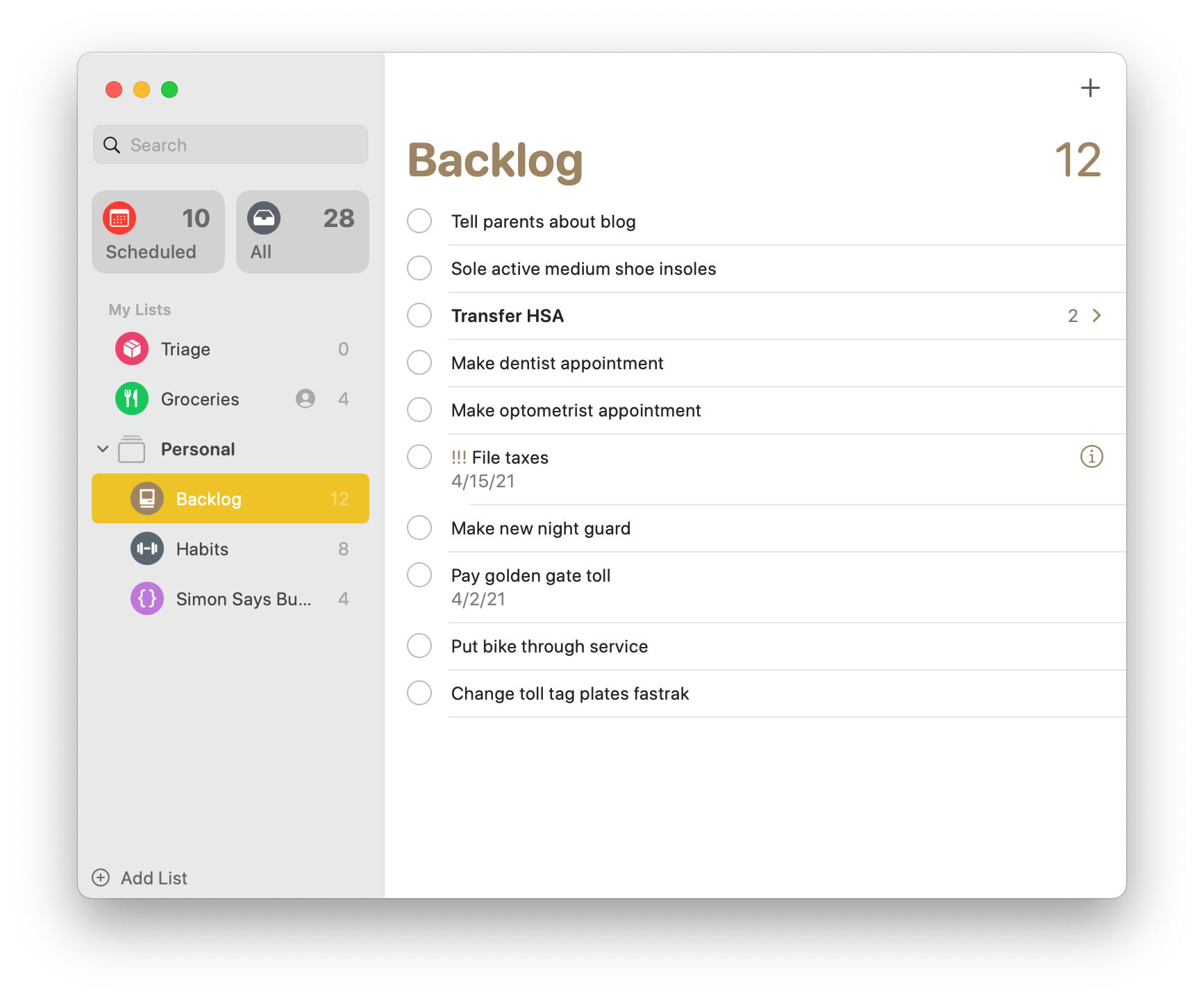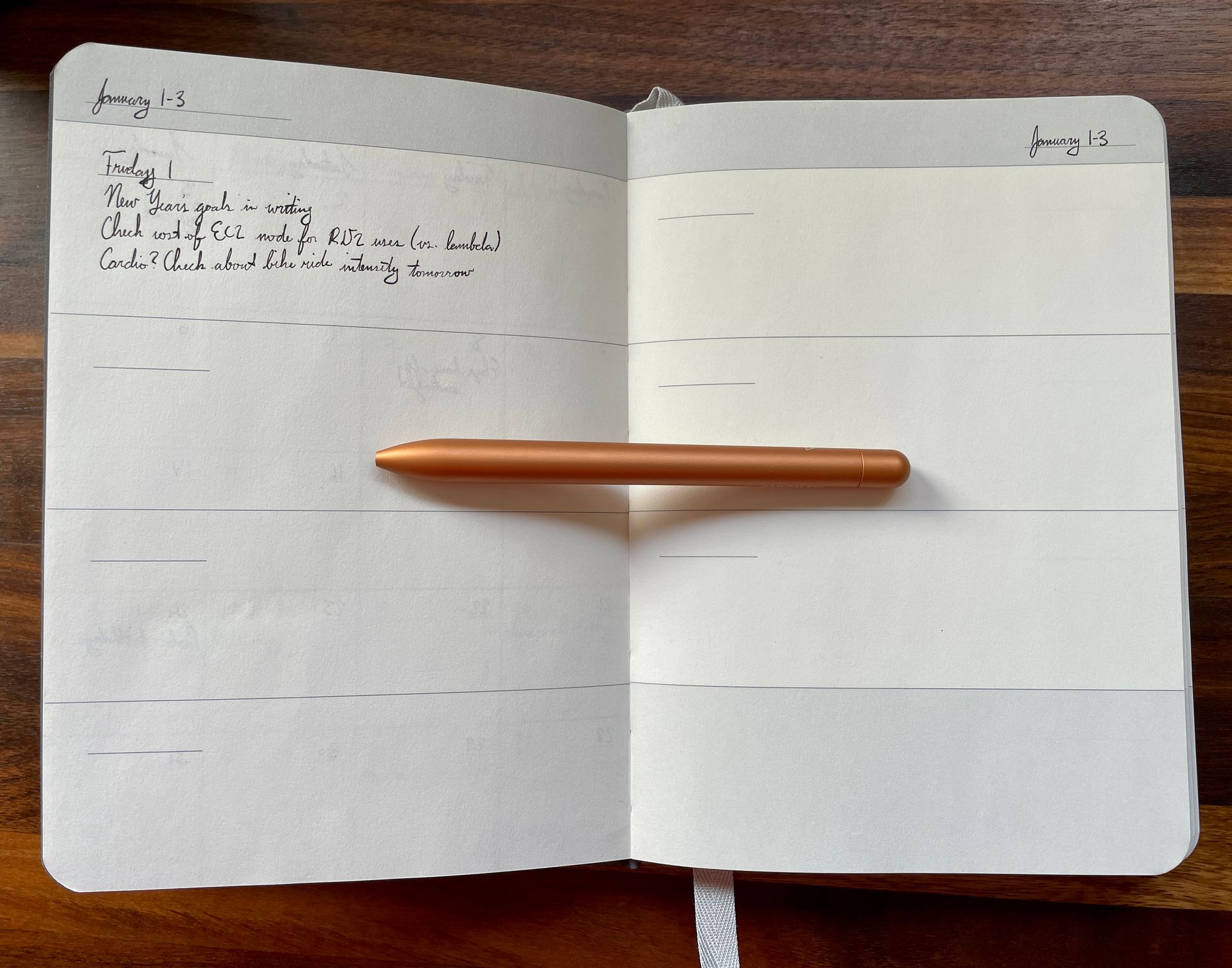For most of my life, I've relied on my memory to track my tasks. Whether it be homework, taxes, or scheduling a doctor's appointment, my memory never let me down. But the responsibilities grew, and while I never missed anything important, things began to fall through the cracks in my memory. I needed a better way.
For the next 3 years, I used a paper calendar to track my life. At no point was it a great system, but it worked just fine for my purposes. But then my responsibilities increased even more, and I felt the limitations of my paper notebook. I needed a better system.responsibilities
Requirements
You may be asking "why not <product>", but I think I can answer that by just listing out the requirements I had:
- Be available on all my devices
- Be able to set due dates on tasks
- Be able to create repeating tasks
- Be able to share a grocery list with another person
That's it. I don't need to label tasks, I don't need a state machine to track task status, and I don't even need reminders on my tasks: I just need a thing that will keep a list of items I still need to do (potentially over many months).
With such a limited set of feature requirements, I came to expect whatever solution I picked would be fast. This eliminated quite a few options I had seen people online using: Notion, Roam, and even Asana all took a noticeable amount of time to load on my phone. If I were managing a business with this tool, I might take the performance hit for the extra features. But I don't (yet) have a use for those features, so I'm not interested in paying the startup cost.
There's a nearly endless supply of todo list apps on the App Store, but when I started looking at those I realized that Apple provided one right out of the box: Reminders. All my devices are Apple devices at the moment (I'm a shameless Apple shill), and my fiancé's primary grocery run device is also an iPhone. I figured I'd at least try the preinstalled application before going to alternatives.
My Reminders Setup
I can sum up my task management system with one image:

This "system" only relies on 3 lists, but you can add arbitrarily many depending on your needs.
Triage
The most important list is my "Triage" list (I believe OmniFocus would call this the "Inbox"). This is my default list, so when I ask Siri to "remind me to ...", she'll file a reminder in this list. When I file a new reminder, it almost always goes into this list first. When I get time to sit down and do some personal work, the first thing I do is go through my list of tasks that haven't been triaged.
- If I can finish the task immediately, I finish it and mark it completed
- If it's something that should get picked up the next time either I or my fiancé go to a store, I put it in the shared list (called Groceries)
- If it's something I need to do on (or by) a specific date, I add a due date and move the task to my backlog list
- If it's something about my current personal programming project, I move it to that list
- Otherwise it gets moved to my backlog
Shared Shopping List
I share a shopping list with my fiancé and it's been incredibly useful. When I run out of butter or eggs, I can add them to the list and know she'll check the list any time she's at the grocery store. And she knows that if she runs out of oats or frozen fruits, she can add them to the list and I'll check it when I make a grocery run.
The shared list only contains things that we trust the other person to get. If I needed to buy more inner tubes for my bike, I wouldn't put that in the shared shopping list because I don't expect her to know my tire size.
The shared shopping list has been great for us because it eliminates the "do you need anything" conversations that come up when either of us goes to the store. We both write in the things we need and trust the other person to get them, so we know there won't be unnecessary trips to the store for that one item the other person didn't get.
Backlog
I have one primary backlog (pictured), but this is where long-lived tasks live. Some people may want more granularity with their tasks (medical vs. financial vs. personal), but I don't really have a reason for that yet. I don't even have a dedicated list for this blog (recurring tasks go under "Habits" for me)!
If my backlog gets too big, I know I need to start pruning tasks. Some things no longer apply and can be deleted. Some were done and I forgot to check them off. Most need to just get done, and so I do them.
Why Not Paper?
With such a braindead, simple system, why not just use a paper todo list?
There are 2 things paper systems struggle with that ended up being deal breakers for me:
- Sharing information quickly is difficult, and shared lists are basically impossible
- Low priority tasks are easily lost over time
It's totally reasonable to put the shopping list on a slip of paper on the fridge and take it with you to the store when you go. But my fiancé and I rarely go to the store from home; we go on the way home from work. And things pile up during the day, so the list may not be up to date by the end of the day.
A lot of my personal tasks are low priority, but still need to be tracked: transferring my old HSA isn't pressing, but I should do it eventually. Making my optometrist appointment has been on my list for almost 6 months, but I'm waiting for the pandemic to die down before going to appointments I don't really need immediately.

But that's not to say I don't love pen-and-paper systems! I keep a daily calendar, and all my daily todo list goes in there. I liked my paper calendar so much that it was my primary task tracking system for almost 3 years! But as I mentioned, it couldn't quite do everything, and so I've adopted the smallest tool that fills that gap for me.

